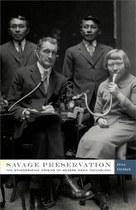An interview with Brian Hochman on 'Savage Preservation'
 Brian Lennon, Director, DCMI: I find especially usefully provocative two suggestions in your book Savage Preservation: The Ethnographic Origins of Modern Media Technology: one, that the imagined decline of Native American languages is linked to the imagined “rise of modern media,” to use your phrasing in the book’s first chapter, and two, that one origin of media studies might therefore be located in the ethnographic linguistics of John Wesley Powell and others. I say “usefully provocative” because while I think the very best readers of your book will not necessarily have found it difficult to make that link themselves, it is likely to be received as an incongruity or even a counterintuition by other readers. Clearly, you sense this, since you admit that such claims may seem “unorthodox.” Might you say something more, first, about the historical relationships you’re describing here, in these formulations, and second, about the incongruity or counter-intuition they may suggest to some of your readers?
Brian Lennon, Director, DCMI: I find especially usefully provocative two suggestions in your book Savage Preservation: The Ethnographic Origins of Modern Media Technology: one, that the imagined decline of Native American languages is linked to the imagined “rise of modern media,” to use your phrasing in the book’s first chapter, and two, that one origin of media studies might therefore be located in the ethnographic linguistics of John Wesley Powell and others. I say “usefully provocative” because while I think the very best readers of your book will not necessarily have found it difficult to make that link themselves, it is likely to be received as an incongruity or even a counterintuition by other readers. Clearly, you sense this, since you admit that such claims may seem “unorthodox.” Might you say something more, first, about the historical relationships you’re describing here, in these formulations, and second, about the incongruity or counter-intuition they may suggest to some of your readers?
Brian Hochman: This gets to the heart of the book’s first two chapters. Many of the questions that motivated the study of media and communications in the twentieth century have origins in nineteenth-century ethnography. How do media innovations influence the course of human development? How do the world’s peoples variously transmit cultural information across time and space? What are the differences, both psychic and social, between groups that have access to modern media technology and those that don’t? These are some of the key questions that anthropologists like John Wesley Powell and Garrick Mallery started to ask at the end of the nineteenth century. They formulated them in response to their encounters with Native American languages, which they thought were disappearing and in need of preservation.
There are a couple of reasons why this narrative might seem unorthodox. First off, men like Powell and Mallery didn’t use the same terms to talk about media that we use today. So seeing the relevance of their work to modern media history takes some deciphering. (John Guillory’s oft-citedessay on the emergence of the “media concept” helped me in my thinking about this problem.) More broadly, the incongruity of these claims stems from the fact that Native Americans aren’t usually seen as having a role in modern media development. Of course, scholars have done a ton of great work uncovering how Native American subjects influenced the history of photography, for instance, and how the technologies of television and cinema have influenced the global construction of native identity. But since the nineteenth century, and perhaps even earlier, native groups have in part been defined by their technological deficiencies. So it should therefore come as no surprise that the study of Native American languages would seem to have little to do with the study of modern media.
Continue reading the interview here.
By: Brian Lennon
Story Date: 2015-01-07T05:51:00+00:00



